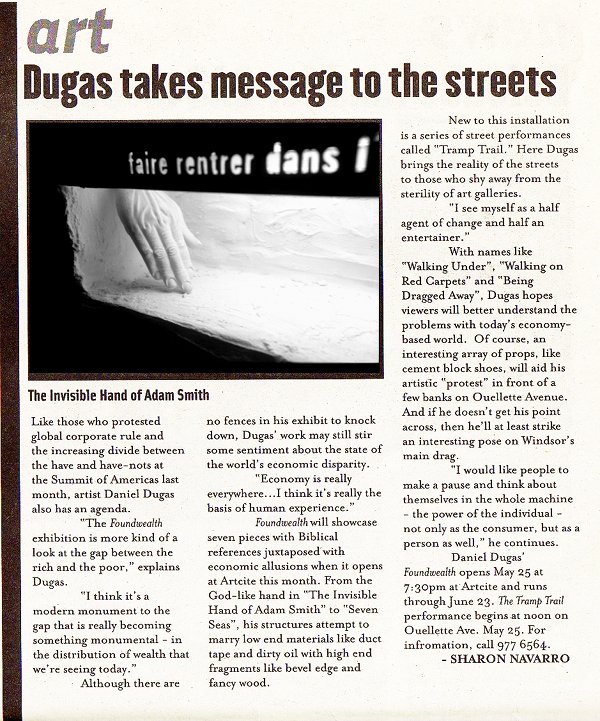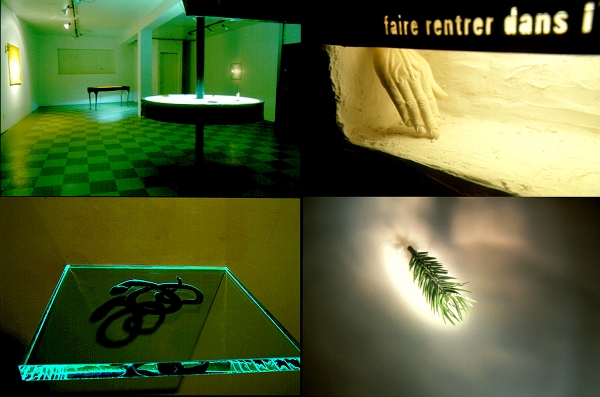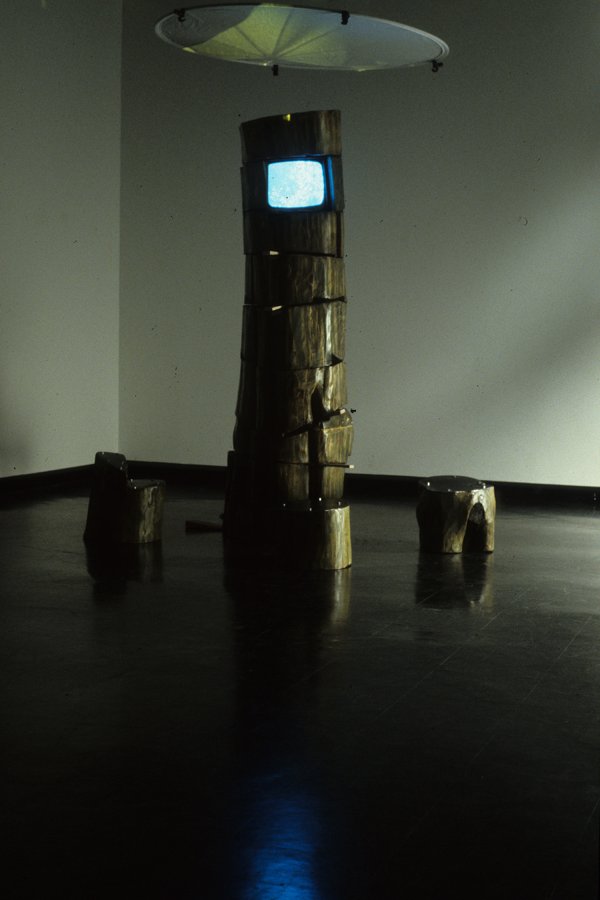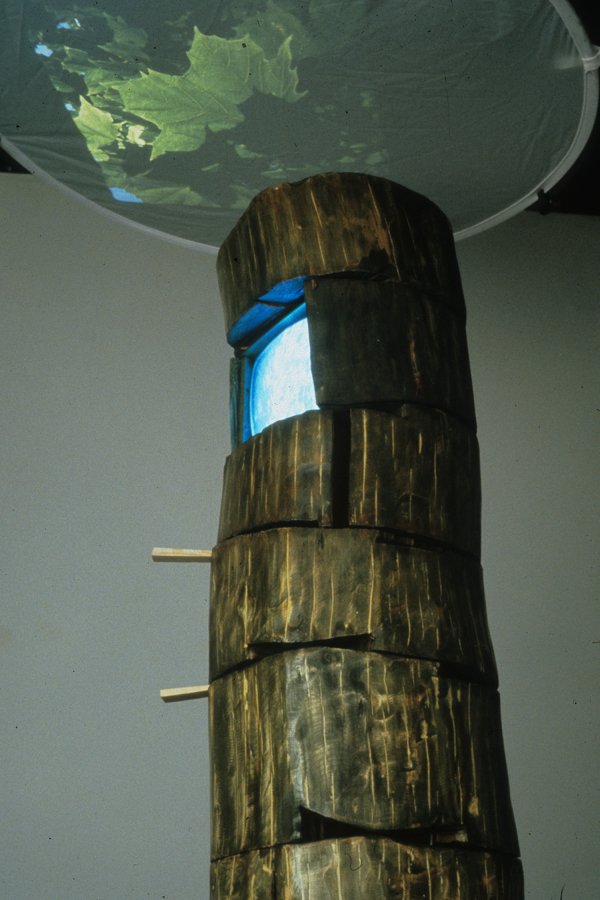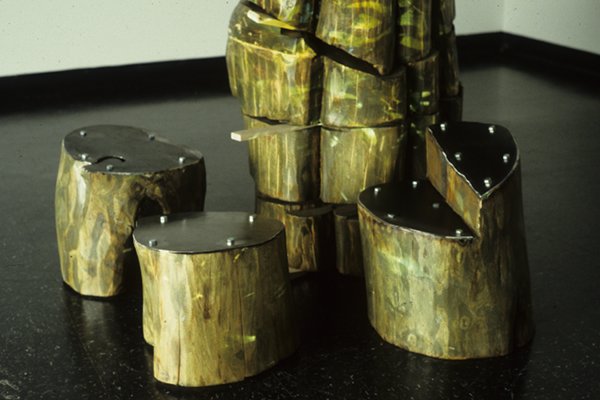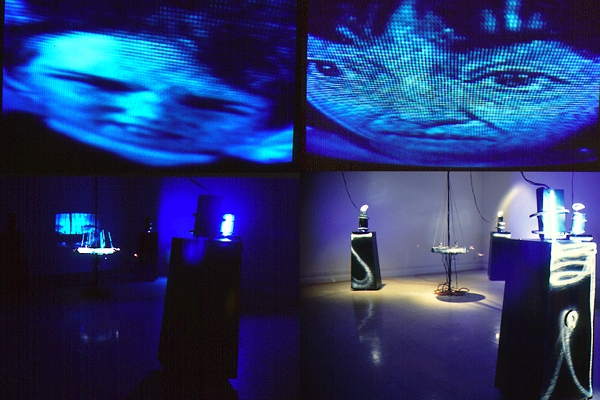Le modèle et la copie (2016)
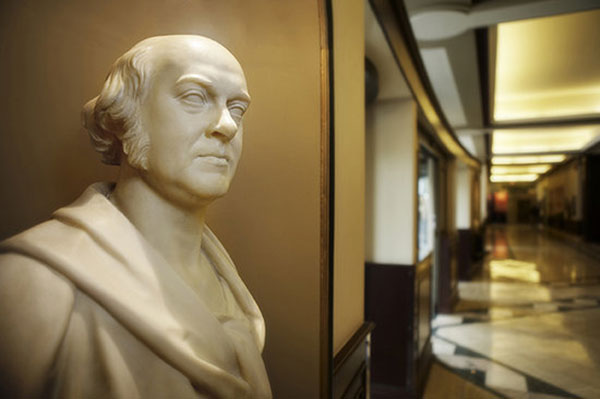
Le simulacre n’est jamais ce qui cache la vérité – c’est la vérité qui cache qu’il n’y en a pas.
Jean Baudrillard
Je croyais que Chirac était du marbre dont on fait les statues.
En réalité il est de la faïence dont on fait les bidets.
Marie-France Garaud
L’hôtel Lord Elgin d’Ottawa a été nommé en l’honneur de James Bruce, le 8e comte d’Elgin, gouverneur général du Canada-Uni de 1847 à 1854. Dans une alcôve du hall d’entrée de l’hôtel, on a placé un buste en son honneur. Comme j’aime toucher à tout, j’ai tapé sur sa tête et j’ai été surpris de constater que l’homme n’était pas fait en marbre, mais en fibre de verre! Je me disais qu’on avait dû mettre l’original en lieu sûr, que ce faux marbre n’était là que pour des questions d’assurances ou de nettoyage. Peu importe la raison, son état révélait un lien de filiation des plus intéressant.
Le père de James s’appelait Thomas Bruce, c’était un aristocrate et un homme militaire qui portait plusieurs titres dont celui de 7e compte d’Elgin. Au début du 19e siècle, il était ambassadeur britannique à Constantinople, la capitale de l’Empire ottoman. La Grèce qu’on disait « ottomane » à l’époque faisait partie de l’empire et l’ambassadeur, qui avait une fascination toute particulière pour la Grèce, parcourait son territoire comme un véritable golden retriever. La pie voleuse plénipotentiaire, grande receleuse, a enlevé de l’Acropole d’Athènes des centaines de statues et les a vendus au British Museum. Parmi son butin, il y avait 12 statues des frontons, 156 plaques de la frise et 13 métopes; la frise du temple d’Athéna Niké et une cariatide de l’Érechthéion! Ces marbres qu’on appelle maintenant les Marbres d’Elgin (comme quoi le crime paie, et ce même si le 7e comte a vendu le matériel à perte) constituent aujourd’hui l’une des pièces maîtresses du musée britannique. La Grèce réclame depuis longtemps le rapatriement des marbres, mais le musée a toujours prétendu être le gardien du patrimoine culturel de l’humanité et n’a jamais accepté de les rendre.
Notre illustre gouverneur général, grand administrateur colonial, avait un pedigree des plus impressionnants, son beau-père n’était nul autre que John George Lambton, 1er comte de Durham, l’auteur du terrifiant Rapport Durham et son père, on l’a vu, était un statuomaniaque international. Notre comte n’est toutefois pas en reste; il a été vice-roi des Indes et a laissé sa marque sur la scène internationale en ordonnant, durant la seconde guerre de l’opium, la destruction du Palais d’été, jardin impérial de Pékin. Quoi qu’il en soit, la statue du fils en fibre de verre qui siège aujourd’hui à l’hôtel semble être la conséquence d’une certaine justice immanente, comme si le fils payait en substance les crimes de son père. Ce qui est plus drôle, c’est qu’en tapant sur le buste, il sonne creux comme pour nous rappeler que l’Histoire n’est pas aussi pleine qu’elle le clame.
Daniel H. Dugas
le 22 août 2016
Notes
Le point de vue du musée britannique :
The Parthenon Sculptures, The British Museum
Le point de vue du gouvernement grecque :
Demands of the Greek government
Pour un exposé favorable des politiques de Lord Elgin, voir : The voice of the people “Lord Elgin” (N.F.B. 1959)
Sculpture Space – Then and Now 1991 (2011)
JUiCYHEADS celebrates 35 years of Sculpture Space!
Sculpture Space is unique in North America for its support of sculptors, both those who come to Utica, New York, as residency participants and those who continue after their residencies as working artists. The organization selects 20 artists each year for two-month residencies and has helped to advance the careers of more than 500 national and international artists since 1976. A non-profit organization with a 35-year record of success. For the next few months JUICYHEADS will be featuring work from Sculpture Space artists. Click on a year and their name to experience their work: http://juicyheads.com/

Then and Now at Sculpture Space:
I applied to Sculpture Space when I was in residency at the Banff Centre. My project, THE NEW PANDORA’S BOX was a two-fold installation work. The first part was a trip around the world, and during the second stage, the Utica residency, I constructed the installation. I convinced my partner video artist Valerie LeBlanc to accompany me on the trip, to share the adventure.
The entries have been collected from notebooks, reconstructed from past memories and / or from revisiting photos and video taken between December 2, 1990 and January 31, 1991.
Daniel Dugas
SNOW
That was a big storm, even for Canadians. And it’s cold and damp. We are wrapped with scarfs, tuques and mitts, walking slowly in single file in the knee-deep snow of Genesee Street en route to Mr. REDS. We meet other walkers going up, coming down. At every encounter we all put one foot in the deepest snow to let the other person pass. From the air it must look like pirouettes of a silent ballet. DD
WELCOME
On December 2, 1990, Daniel and I arrived in Utica via greyhound bus during the first snowstorm of the winter. Although large and fluffy flakes began accumulating during the final miles of the bus ride from Montréal, we could not be held responsible for bringing it south, the Mohawk Valley of Central New York State lies smack in the snowbelt. VL
CHRISTMAS IN UTICA
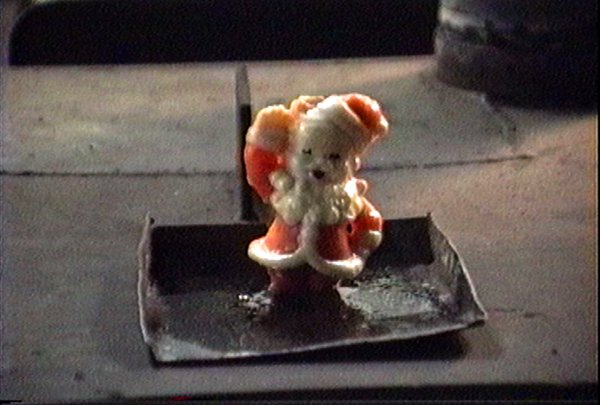
They are called Appalachians, Adirondacks and sometimes they are said to be linked geographically to the Canadian Laurentians. In any case, the snow covered mountains and hills there have that familiar purple/grey aura of bare hardwoods nestled in snow. When winter comes to Utica, it is a Christmas card world straight out of Dickens. VL
WAR
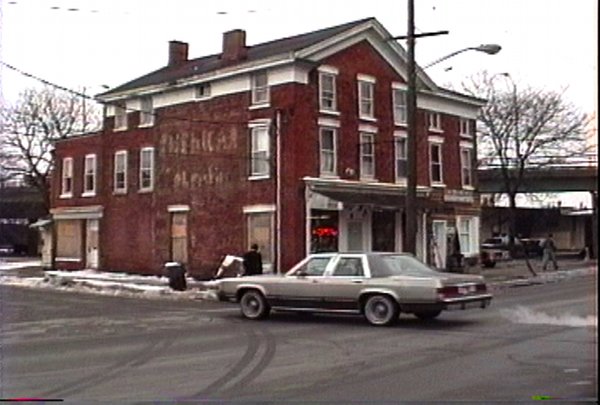
January 11, 1991 – 7 pm, Sculpture Space studio
The radio is on. Politicians are debating the possibilities of going to war. The stove is hot and it’s good because there is a big snowstorm outside. The resonating voices and the radiating heat gets mixed in front of our eyes. After hours of discussion the senators approved the Senate Joint Resolution. War is coming. DD The Persian Gulf War Resolution
NATION OF WARRIORS
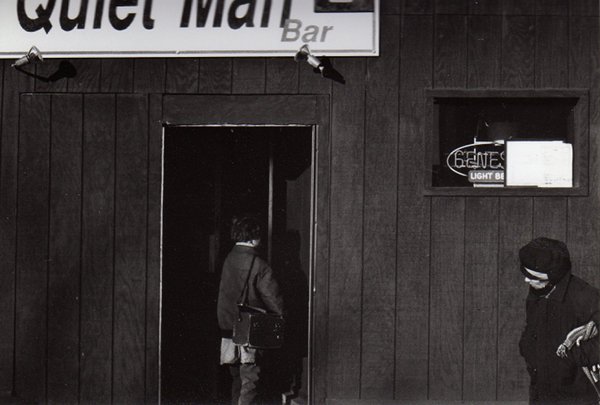
Once the Gulf War started, B52’s made night passes over Utica with the regularity of a milk run. Off they went from the Rome Air Force base, carrying soldiers and supplies from the start to the finish of the bombing time period. Meanwhile the debate raged on NPR, and many discussions in the cafés and on buses turned to worries about the threat of a prolonged state of war. In my heart, I was a visitor to the country, on the streets, I was drawn into the news that made every headline. The waitress’s father-in-law was called up as a reserve officer, one of the finest mechanics in town. The car salesman’s daughter was an infantry soldier, he hoped for the best over coffee and eggs. Generals ‘Stormin’ Norman’ Schwarzkopf and Colin Powell were all over the television news. Rehashed and rehashed, tactical victories gave opportunities for veterans to enter the fray. Old scraps were revisited as the current war played out, and Utica resembled the stage set of The Deer Hunter movie, more and more each day. VL
APARTMENT
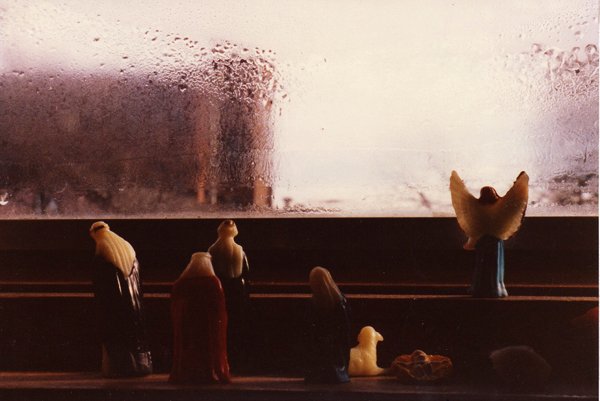
We got a small apartment on 939 Schuyler St. It’s not big but as Jonathan (Kirk) pointed out “it’s cozy”. There’s a hot plate and a toaster but the two can never be powered at the same time, as it will create a short. And we will have to ask the owner to change the fuse. The shower is also ‘unique’; it‘s perfect for anyone under 5 feet. But, best of all are the trains. It was worth taking the apartment. The first time we saw it, we heard a loud sound and then another one, louder, closer. We opened the curtains in a hurry to witness a freight train in all of its glory coming down the middle of the street right under our balcony. You could almost reach out and shake hands with the Conductor! DD
CULTURAL ICONS
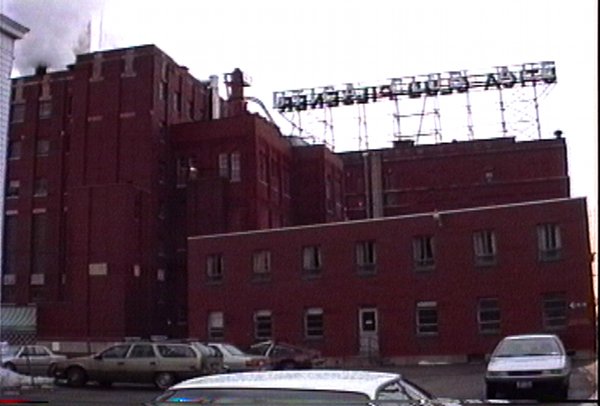
Having lived for five years in Kingston, Ontario, as a kid, I was somewhat familiar with the cultural environment of Central and Upper New York State – from television of course. As I sat glued to the T.V., I was storing up a range of programming highlights from Buffalo, Syracuse, Rochester, Watertown, Ithaca, Utica and all points in-between. Cartoons and black and white re-run movies started airing very early in the morning. On weekends and holidays, I woke up early to soak it all in.
Upper New York State was a far cry from what I expected to find in the Big Apple, and yet different from what I had come to know in Canada. With television as my window to the world: life down south in the United States of America, I knew that the hot dogs were bigger, more red; there was a bigger variety of candies; and dime store specialty gifts were more affordable.
All of those years later, as an adult, visiting Sculpture Space brought me to the actual source of some of those cultural icons already familiar to me. I knew before arriving that bowling had been VERY big in Utica. I personally felt that one of the most interesting programs on T.V. was the Sunday bowling. Far from boring, the soothing voice of the announcer whispered the step by step action, building the tension of each player’s profile and emphasizing the high (monetary) stakes involved in winning the tournament. And there were Utica Club Beer ads! The jingle of the tournaments’ sponsor came back to me when I stood in the train yard outside the still-active Utica Club brewery. The factory, with its high chimneys and the oversized letters’ sign towered high above street level, lending a larger than life silhouette to the Utica skyline. VL
STOREFRONTS
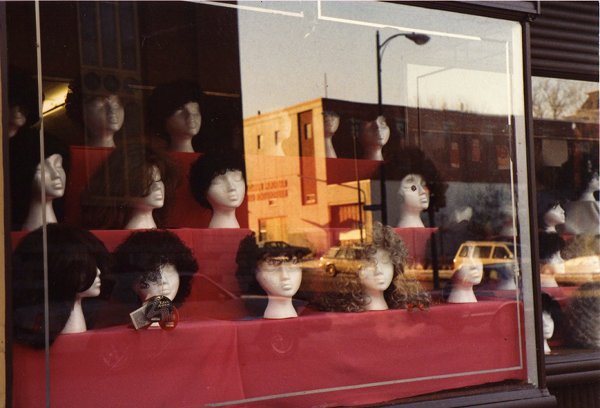
Storefronts are fascinating. They are markers of time, documenting life. In the few weeks since our arrival, we have noticed a lot of wig stores and wonder why. It seems that every block has one. Styrofoam heads with curly blond or long black hair resting on shelves, looking out all day long at people going by. Somewhere downtown, between two wig stores, we saw an abandoned shoe store. The front window is still offering a dazzling display of boxes sitting on pedestals. Everything is coated with a layer of dust, 3 years thick at least. It looks like the tomb of some great Egyptian ruler. There are also wedding dress storefronts. Today we stopped in front of one and took pictures. DD
SCIENCE FICTION MEETS REALITY
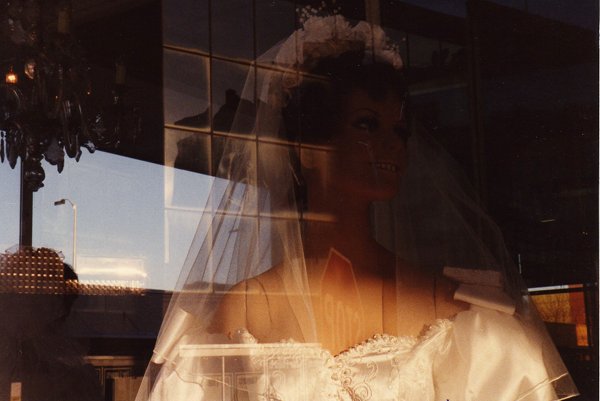
When I walked on the street in Utica, a million story ideas appeared in my mind. Every turn of the corner brought a unique storefront, café or colourful local character. I had travelled all my life but was struck by the rich character of this city. For some reason, each encounter with a store clerk or conversation on the bus, seemed to present a string of other possible outcomes, all of them mysteries.
One day, after being spooked out by passing the darkest of abandoned parkades, I looked into a store window to see a perfectly arranged shoe display of the finest leather shoes. Signs indicated the qualities of the particular brands carried and looking past the window box, in-store displays, and stacks of shoeboxes resembled a neatly organized library, complete with a sliding ladder to reach all of the available sizes. It was definitely a very classy shoe store.
The only quirk about the place was that it was abandoned, and all of the fashions were 1940’s styles. There was a thick layer of dust everywhere and everything was faded. It looked as it the owners had just disappeared into thin air, leaving not a trace, and yet, in this city with a vibrant, animated street scene, no one and nothing had disturbed that shop. I had often thought about the fact that Rod Serling, the science fiction writer of the television series The Twilight Zone had lived in Binghampton, a short distance from Utica. When I thought about some shows from the series, I began to feel that the science fiction reality of his stories were hovering just below the surface here in Utica. VL
STOVE
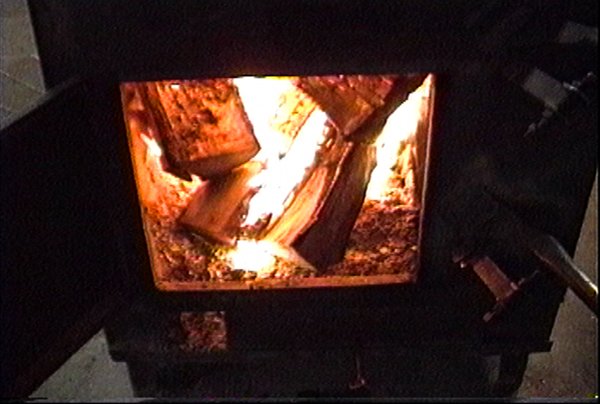
The wood stove at Sculpture Space is incredible. It is a colossus object that looks like nothing else on earth. It is the source of heat for the whole studio, the beating heart that allows residents to carry on. When we arrived, in early December, Sylvia de Swann showed us the cords of wood outside and said, “Use as much as you need”. We did. DD
MUSIC
Music all day, music all night! We all brought our favorite cassettes, but it’s Tracy (Brown) who has the biggest collection. We listen pêle-mêle to: Voivod; John Cale; the grinders and the saws; The Red Hot Chile Peppers; Sinead O’Connor; the MIG welder; Bad Brains; NPR; hammers and cutters; all flowing and bouncing freely, helping us to concentrate and to create. DD
OUTSMARTING THE DOGS
And in Utica there was Sculpture Space, that extremely well equipped and highly accommodating support for sculptors. After a few days, I felt inspired to do a documentary about it. I began to shoot possible cutaways. I carried out preliminary interviews with Daniel, and the other artists currently in residence: Tracy Brown, and Charlie Citron.
WUTR, Channel 2, the local television station supplying a percentage of local programming was located on top of Smith Hill in Deerfield, but its official address was Utica. I got dropped off outside of the station one morning to meet with the Programming Director. Unfortunately, the weight of the impending war was thick in the air and the meeting was brief. If war was declared, all programming would need to focus on that event. Peaceful cultural concerns would be moved to the back burner. I started down the hill to catch the bus, with not much hope for moving the documentary ahead. That was when my real problems arose.
The walk back down was through a remote section of landscape with not much around but the dogs. It seemed that everyone had already left for work and no cars passed me by either way. I would not have cared except the walk was close to two miles and each abandoned home or farm had at least one dog. I quickly developed a life-saving strategies. Looking to the edges of the snow-covered road, I filled my pockets with as many rocks as I could find. As the first of two beagles raced toward me from their driveway, I began throwing rocks. No one was hit or injured but they got the message quickly and doubled back home yelping in defeat. Whew! There were two more encounters and then I used the ‘black bear strategy’ of lifting my black leather coat up high over my head. On both of the other encounters, I charged toward the dogs yelling as loud as I could. Unbelievably, it worked. By the time I got to the bottom of the hill and found the bus stop, a german shepherd in his yard started to run for the driveway, miracle of miracles, that owner was home and yelled for the dog to get back in the house. I returned to Sculpture Space without a strong prospect for the documentary but I had a few stories to tell. My own war to return went well. VL
ESPRESSO
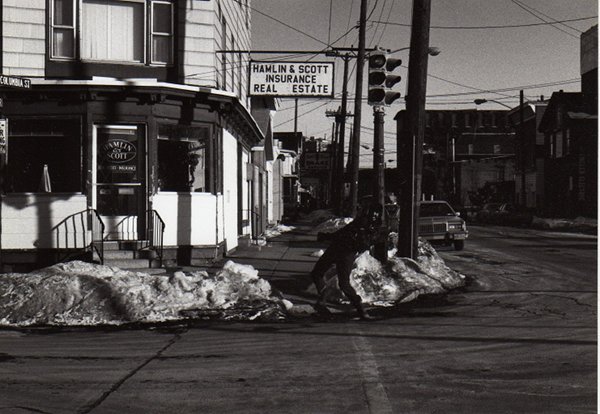
We needed a good coffee, something strong like an espresso. We went out, looking for some. After a little while, we saw in a window display, an espresso machine and some little Italian flags in coffee cups! There was also a very small sign with the magic word Café above the door. Despite the sign, the coffee machine and the flags, this place didn’t really look like a Café or a restaurant. There was something private, secret about it. Guided by our addiction, we opened the door. It was quiet. We saw a long counter and two little red enamel tables. We looked at each other full of hope. As we slowly made our way in, a man showed up and glared at us. There was something Boris Karloff about him, something in his demeanor that was telling us that this might not be the right place. But nevertheless we had found the place, we were in, and we were thirsty, there was no way back. We risked, “We’ll have two espressos?” There was a slight pause, a silence, and then the man pointed to one of the tables. We sat down. There was no music playing, no flowers on the table. He was already behind the counter working. We could feel his gaze. The smell of the coffee started to take over. After he put the cups in front of us, we paid him. He pocketed the money and disappeared behind a curtain at the end of the counter. Then, all of a sudden we heard a flurry of other voices, two or three other men. They were speaking, yelling in Italian, swearing in English, the energy was on the angry side to say the least. It felt weird being there. We hoped that they were not talking about us. We drank our espresso in a hurry, put a fifty-cent on the table and left. As we stepped outside, we could feel the adrenaline rushing in our veins, it felt pretty good. DD
⁂
After Sculpture Space Daniel Dugas and Valerie LeBlanc moved to Chicago where they did each their Master of Fine Arts Degrees at the School of the Art Institute. They each continue to carry out individual creative projects and collaborations. Social and political aspects of the world, as well as the technological changes that continue to augment reality are the pivots on which their practices revolve. At the heart of their activities resides the desire to establish a rapport between what is experienced and what is imagined; the ideas that emerge to see the light of day, and those that remain below. The underpinning motivation is to move communication forward.
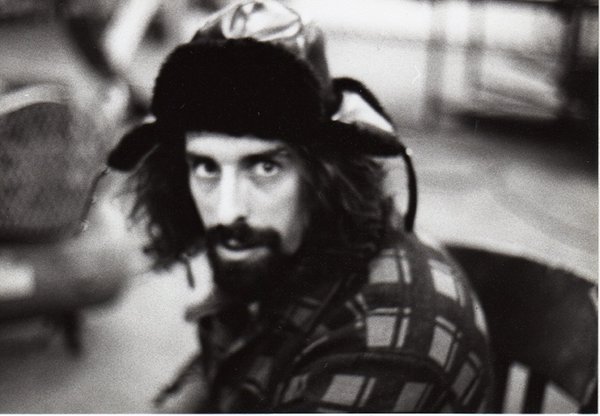 Daniel’s website: http://daniel.basicbruegel.com/
Daniel’s website: http://daniel.basicbruegel.com/
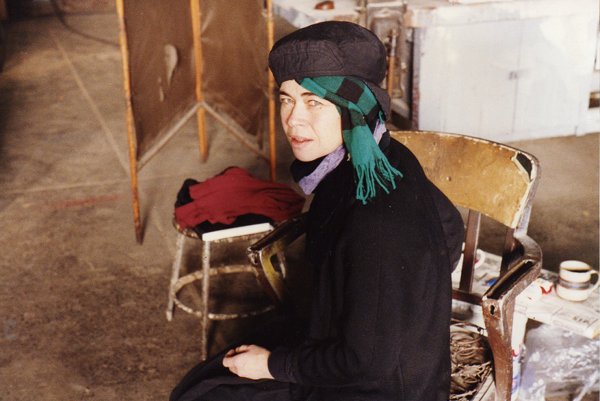
Valerie’s website: http://valerie.basicbruegel.com/
4 short videos YouTube
Sculpture Space 1991 (2011)
Sculpture Space, the internationally renowned artist-in-residence program for sculptors, is celebrating its 35th anniversary and the online magazine JUICYHEADS is doing a feature story about it. As an alumnus I can tell you that this was and is still an amazing place. I had the chance, along with Valerie LeBlanc, to be part of it during the winter of 1990-1991. recently, we sat down, to open up old note books and Hi8 tapes to revisit Utica. These 4 short videos represent part of our Utica experience.
http://www.sculpturespace.org/
NB As a results of bogus copyright infringments warning I decided to delete all my videos from Youtube – Dec 2012
Foundwealth (2001)
• Artcite, Windsor, ON, May 25 June 30, 2001
About foundwealth
What really got me going with the FOUNDWEALTH project is a quote I read from the Canadian investor Andrew Sarlos, who was called the “Buddha of Bay Street”. He was quoted as saying, “I like gold, real estate, and floating rate instruments”. I thought, “so do I,” even though I did not know what he meant by a floating rate instrument. From the Buddha of Bay Street, I met Pope Leo the 13th who, in a 1891 encyclical letter, wrote on the condition of the working classes. The letter underlined the duties of the rich and the duties of the poor. I read the amazing story of John Sutter who was in the process, through his sawmills, of becoming one of the wealthiest men on the Pacific Coast. The discovery of gold on his own property in 1848 ruined him. I got interested in the similarity between the gold rush and the tech rush. I saw, floating in the market, in the office towers, the invisible hand that Adam Smith. He was the Scottish Economist who, in 1776, published his theories: An inquiry into the Nature and the Causes of the Wealth of Nations.
FOUNDWEALTH is not a linear story. There is no particular story, only a collection of stories. It is about money and it is about the relationships between people. It is about the gap. It is about the pursuit of happiness and the idea that joy springs up from the consumption of products. It is about consumerism and society’s danger of self-combustion. It is a choice of events and moments, of fragments that I have put together to help me understand what is going on. I wanted the installation FOUNDWEALTH to be a poetic reflection, a kind of frontal collision-relationship of the rich and the poor. I had an image of a bridge made of burning rags that were thrown over the abyss where the river called Economy runs furiously. I wanted the carpet cleaning trainee to talk to the capital risk investor; maybe they could find some common ground?
I have tried to matched high end materials of beveled glass, a light table, thick carved glass with elements of a lower denomination: dirty oil, broken glass, discarded objects, raggedy assemblages. I was attracted to the showcase idea, similar to the ones found at the Gold Museum in Bogotá. I wanted to have inserts in the walls of the gallery; to suggest a relation between the installation and the building that is similar to the relation of the Economy with Society. I wanted the light to be seen and to indicate both the end of a journey and the beginning of a certain degree of hope. I felt that the moment where the light was seen was a moment where space and time were crunched together into a new thing; the split second where choices are made. I wanted the installation to be about that moment where everything could happen. This moment of decision, or indecision looks a lot like our point in time. It seems as if we are moving into a corridor of weightlessness. Acting like astronauts in a tube, we have to look, while lost in the dark, at the light that may come through the cracks; to guide us and to inspire us to continue forward, to believe that there is some worth in everything and that maybe wealth is not what we thought at first.
The installation is composed of seven works: Wealth Maker; Fake Wealth, Found wealth, Seven Seas, The Invisible Hand of Adam Smith, Huge Promises, and Snake Oil (every thing will be OK). The number 7 has always held a powerful and mystical place in the world; we have only to think of the seven seas, those navigable waters of the world; roads to treasures and adventures. The Seven Marvels of the World included: the lighthouse in Alexandria; the Seven Deadly Sins (Envy among them); the Seventh Heaven where God and the most exalted angels dwell; and the Seven -Eleven, a place where you can buy a 6-49.
Is wealth something that one can find? How can it be found and how can it be maintained? Maybe it happens simply, by fortune. Maybe it happens by ingenuity. Perhaps it is a bit of both, luck and skills, patience, timing and audacity. The final answer belongs to Machiavelli:
“Without that opportunity the strength of their spirit would have been extinguished, and without that strength the opportunity would have come in vain.”
My personal brush with wealth
•Winning a Mini-trail Bike
At the time I was 14, I went to a Shopping Mall in Moncton, NB. My attention was suddenly captured by this shiny and beautiful bright blue Honda 50cc mini-trail bike. One of the men, at the Lion’s Club booth, asked me if I wanted to buy a ticket. Without hesitation I bought three. I was sure to win. I visualized myself riding full throttle on the trails around town. A few days later, early on a Saturday morning, I heard a big commotion upstairs in the kitchen. I heard people shouting the loudest that they could: YOU WON! YOU WON! I was pleased but not surprised. I had a strange feeling that the bike was mine when I bought the tickets.
• The Gold Museum in Bogotá
In 1978, after high school, I went into the Canada World Youth Program. The country I had chosen to go was Columbia. It was an important and an amazing experience for an 18 year old. We were 15 Canadians and 15 Columbians living together, first in Montreal for the Canadian segment, and then in Medellin for the Columbian segment. One night in the countryside around Medellin, I remember to have met other people of my age that were guerillos with the armed group M -19. They had rifles and looked very serious. On another day, my group was invited by a woman into her home. She lived with her family. The home had just one room, with just one bed and a dozen babies and kids sitting on it. The house was made with cardboard and pieces of tin. The structure was literally holding up with strings. The woman offered us coffee to drink. I remember thinking that all of the coffee she was offering us would be coffee they would not have at the end of the week or at the end of the month. A few weeks later our group visited the Museum of Gold in Bogotá. At the Museum the group was broken in small units. Soldiers with automatic rifles took us into a corral like anti-chamber. A set of doors opened up, and we were permitted to enter a dark room. Four of the guards came with us. They closed the doors and then slowly, in a dramatic manner, lights went up. The room was made of four walls covered with windows. The cases were filled with gold of the Incas. When the lights rose to full intensity, we were all bathing in the gold light, in a surreal silence. It seems that we had become gold nuggets ourselves.
• My Old UIC Office in Calgary
I was getting UIC at some point in Calgary, and the office that was in charge of my case was located on Fifth Avenue in the North West of the city. Just before moving out of Calgary I notice that the building was for sale. A few years later, I was watching the news about the fraud and collapse of the famous gold mining company BRI-X. I was stunned to see my old UIC building as the BRI-X headquarters. I was amazed to see the ‘now dead’ president of the BRI-X gold mining company entering that building. His building, where I used to fill my cards with the now infamous YES, YES, NO, YES, YES, YES. Lately, I was walking front of the building known simply today as the One Nineteen. From the street one can see that the letters are made of bricks painted gold. It is relatively ironic when you know that the scandal that rocked BRI-X was centered on false claims relating to gold deposits
Mega Merger or Meager Merger?
” Money is like a sixth sense, essential for the complete use of the five others. ”
Sir Winston Churchill
” Before wealth the most ordinary sentiment is not respect it is envy ”
Fustel de Coulanges
I am not an economist but I am interested in the Economy. I am interested in Economy because it is everywhere and it defines everything, it touches everyone. In other words, I am interested in it because we are surrounded by economies of all kind: large, small, growing, struggling, abusive, miraculous, reckless, inventive, greedy; ever expanding like a big bang of its own origin. It is at the root of human experience: glorious and tragic; our relation to the world is often understood on an economic level. We are reacting to the Economy or to the absence of Economy. According to Jacques Adda, in La mondialisation de l’économie, we have arrived at the ultimate finality of an economic system invented 1000 years ago, by the mercantile cities of the Mediterranean. 1
News of the economic world has invaded our lives. We are saturated, over inundated by it. We are mesmerized by the growth of the economy, by the expansion of economy; we have become obsessed by the power of industries. There was a time when there was no mention of economic indices on television news. It was considered uninteresting to the public. Today, the Dow Jones, TSE, CBOT, NSDAQ, and NEKEI are all necessary, are all important, and unavoidable. We need them. They mean something. Somehow investment has become fun and sexy. RSSP=SEXY. GROWTH OF FUNDS=GROWTH OF FUN. And sometimes it is possible to have the impression that ‘it is working’ for everyone. In fact, it is working very well, but for a small percentage of the population; 86% of bull market gains in the past four years have benefited the richest 10% of the population. Are they the ones that driving the new cars? Now it is possible to go into a parking lot and have a Jeep Cherokee in front of you, a Jeep Cherokee in back of you, a Jeep Cherokee on your left, and a Jeep Cherokee on your right; and if you really look around, you will notice that you are trapped. We have become sophisticated consumers with surprisingly few tastes. Actually consuming goods has become a spiritual activity and heaven is a wasteland ready for condo development.
According to a Warvick University research, funded by the Economic and Social Research Council of Britain, the price for happiness is at least $2 million. This amount can, according to the study, give “a significant boost to well being.” 2 In 1999 Monopoly was adding its first new piece in 47 years. A sack of money joined 10 others playing pieces that come with the classic board game: a battleship, cannon, dog, horse and rider, iron, shoe, thimble, top hat, wheelbarrow, and race car. Monopoly held an election asking fans to choose between the sack of money, a biplane, and a piggy bank. About 1.5 million people voted at toys stores, by telephone and on the internet. Monopoly was invented during the great depression in 1935. 3 As of 1999-2000 there were seven million millionaires in the world. Since World War II we have had 9 recessions. There are a lot more millionaires than recessions.
Falling Through the Cracks
Study after study reveals that the economic Gap between individuals in society is being defined more clearly. The official position seems to be a desire to close the Gap, but behind the closed doors of power, its function is recognized, maintained, expanded, praised and enjoyed. The existence of the Gap must be a proof in itself that it is a wanted situation. Jean-Jacques Rousseau wrote that the first person that fenced off a field and said: “This is mine”, and found people to believe him, was the true founder of the civil society. He went on to say that the world would have been spared crimes, wars and murders if only one person would have taken the stake out of the ground and filled the hole, while shouting to everyone, “Beware of this impostor, you are lost if you forget that the fruits belong to everyone and that the earth is owned by no one! ” 4
Here we are now, like a tribe that lives on a land being ripped apart by a giant earthquake while all of the members can only look at the crevass getting deeper and wider every day. From time to time one can hear: “Watch out! Look out! Step back from the GAP! Become self-sufficient: Sell a kidney!” But most of the time it is too late. The ones on the edge are diving headfirst, sliding into the man-made Grand Canyon. We have taken the custom of saying, “They fell through the cracks.” The only hope, for the ones that are falling, is that the hole will have no bottom. This absence would make the fall eternal, it would be like a gentle slide through the cracks with no one ever being hurt.
The Gap in the Head
Four kids, well dressed, riding BMX bikes, jump from the train station onto the street. The backdrop is a row of taverns and social services agencies blend together in a kind of neo post geo gothic architecture that means nothing to the people who inhabit it. The kids yell to some customers “You can’t even walk on your own legs, bunch of dirt, fucking scum bags! ” The Gap is in their heads as well as in their hearts. It has allowed them to distance themselves from others, and at the end of the day, from themselves. It is easy to see who is holding the shitty end of the memory stickä. The Fabulous Four left the scene, filling the sunset with all the dust they could make with their tires. The Gap is a serious phenomenon that invites exclusion. This is why we have television shows, which reflect the popular psyche, shows such as Survivor, The Mole or The Weakest Link. They are teasing our Roman excitement for the kill. The basic bottom line is that in order for wealth to exist there has to be a lot more sad faces than happy ones. In 1970 the French President Georges Pompidou was asking what was to be done with the high unemployment level that was crippling the French State at the time. One of his advisors told him that is was not a problem but a solution.
Engulfing Gap
An ad on television reminds me of the kids on the BMX bikes. The high end / low-end spot features the famous Formula One driver: Jacques Villeneuves. Jacques (high end) drives a yellow Honda Civic to a streetlight. He is soon surrounded by group of squeegie kids (low-end). They start to work on Jacques’ windows with ardor in role-playing that is reminiscent of the pit workers at a car race. A clock calculates their performance like at Macdonald’s or at Burger King. Jacques looks at them furtively, with distance, like a Russian Tsar floating above the little people. He is protected by the armour of his car; his own little gated community on wheels. He is absorbed by the glory of his class and enveloped by a grand solitude. The kids are done, the time is up. It seems like a good performance. One of the kids opens one of his hand toward Jacques. He his asking for his due, pay for the work he has done. Jacques does not look at him, nor does he pay him, he simply drives away. And then from a distance he looks briefly to his rear view mirror. If you superimpose the gap between people and the gap within one individual does it create a moiré? Will it give you a headache and split your head in two parts like a ripe fruit?
According to an article recently published in The Globe and Mail, the rich are enjoying their wealth more than ever and are not shy about displaying it. The Politically Correct era in which being rich was a burden is finally over! The shareholders are standing firmly on their ground. Example: a recent poll on the Netscape homepage asked people if the pharmaceutical company should offer AIDS drugs at a lower cost to poor countries in Africa stricken with AIDS. The response to the poll by those surveyed was no. (64%)
Such repulsion for humanity is ultimately contributing to the creation of radical organizations such as the Earth Liberation Front who are setting the symbols of suburban success ablaze, “We can no longer allow the rich to parade around in their armoured existence, leaving a wasteland behind in their tire tracks”. 5
The Gap has just gotten a lot bigger, a lot more spectacular. We recently witnessed a US millionaire businessman, Dennis Tito, becoming the first space tourist. 6 Tito paid $20-million US for the trip and fulfilled, we all hope, his wildest childhood fantasy. The chosen few can now float anywhere they want, even around the cracks. From a distance they are free to do a little anthropological study of how falling people wrestle with gravity. One man’s holiday (20 million US) is the collective amount that 100,000 people can expect to earn in one year in Madagascar. 7 It is telling of how wealth is being distributed. Mr. Tito might be a nice person, the fact that he can afford to mingle in the International Space Station (ISS) has no real bearing on his individual qualities. No offence toward Mr. Tito, but with space there is always a symbolic value. We were told that a stroll on the moon was a giant leap for mankind. For the poor, Tito’s vacation in the ISS will stand as a monument to the Gap. In order not to see the poverty, and the misery, and the dirty streets of this world, it might become easier to go into space. It might also be harder for groups such as ELF to blow up space stations.
Notes Towards New Economic Symbols
When I started to write these notes, I wanted to create something positive. This feeling was confirmed and reinforce by another Globe and Mail article, this one by Alan Freeman : Activists’ intimidation a threat to democracy itself. 8 Freeman’s article was written in the wake of the Summit of the America’s. The article talks about an Animal Activist group called Stop Huntingdon Animal Cruelty. According to Freeman the group is conducting a campaign aimed to shut down the Huntingdon Life Sciences Group PLC, a laboratory that performs tests on animals. Alan Freeman talks about the Animal Activists’ violence and destructive mindset. He also mentions their chilling web site, but forgets to give an address. What is chilling, is the vigor with which opposition is met.
The timing of the article is not a mistake, Freeman and others are trying hard to depict all activists in the same light. Small groups of resistance or protest are a threat to democracy itself. Democracy must crush them as soon as they appear. Will Democracy need to silence every voice of opposition in order to survive? As Capitalism expand and test the limits of tolerance, the demand on nature will increase. There will be people to take the stakes of the fences out of the ground and to fill the holes saying that the earth belongs to no one person.
Personally I do not want to be a threat to democracy itself. This is why I am contributing a new interpretation of these economic symbols in an unthreatening manner. I hope that they can be used in a meaningful way for the common good of humanity.
• The Bear and the Bull
The Bull
We say of people that they have balls; what we mean by that is that they have the reproductive capacity of a bull. That is why those people usually wear loose fit pants to accommodate their huge sexual attributes. They are ready to mate, anytime, anywhere; they can directly invest in stocks on the go using their laptops and cell phones. In brief, their own briefs are full of potential and that confidence is showing all the way. The fight between the Bull and the Matador in the Spanish Corrida is a beautiful expression of the sexual energy and the confidence attributed attached to these animals. To excite the Bull, the Matador waves a red cape. He also wears this glamorous costume with blinding tinsel and sparkles. The Matador starts to dance and the Bull charges, the Matador teases and dodges. In the dusty arena you can see the Matador arching his back and thrusting his sex in the Bull’s face. The Bull is mad now but the Matador has that thing called confidence. And you know that he is confident when you realized that his genitals are covered only by a thin silk opaque pantyhose! The fight goes on and if the Matador usually wins. He will plunge his sword into the flesh of the wounded Bull. At that moment when the hard metal penetrates the Bull’s insides the crowd chants, “To the Vagina! Vagina! Vagina!”
To understand the dynamic on the floor of the stock market it is useful to remember the Matador’s mindset and to never forget that he wears the tight silk pantyhose.
•The Bear
The Bear was adopted to symbolize slowdown of Economy, mainly because it hibernates. When consumers hibernate they don’t drive to the malls to buy stuff that they think they need. Instead they stay home and they slowly burn the goods they have already accumulated. For fear of waking up, they don’t even put the lights on. They don’t shovel the snow that is slowly falling outside their houses, burying them and transforming them into coffin-igloos. Everything stops, even the television broadcasts, the only light now illuminating the sarcophagus, are slowing down. Show Hosts can hardly pronounce the names of the guests. The whole fabric of the world is inexorably freezing over. Fear installs itself deep inside the hearts and the mind of consumers. Wild thought patterns starts to emerge: Will I lose my job? Will we lose our house? Will spring ever come back? Will I stay on top of a high speed train when ‘hobo times’ come back? And then the whole depression era thing, the dust bowl, the soup lines comes haunting us.
Solitary by nature the Bear roams on a huge territory, but unlike the Cow-Bull, he is a wild animal. His freedom is what really fuels our fear for the beast. From time to time we hear stories of people being killed by bears. Tourists, runners, walkers in the woods become slow moving targets. A Bear runs faster than the fastest man on earth, it can climb trees faster than the most fit of monkeys. When it stands on his back legs, it rises as tall as Paul Bunyan himself. It can smell food that is placed inside hermetically sealed bottles immersed into the water of a river. This is probably why there is no Corrida with Bears. The Matadors would have their pretty costumes chewed up in no time. But luckily, they go to sleep every year, it is good news for us but bad news for the Economy.
Hibernation is a funny thing; it is seen as a form of laziness. That does not fit very well into protestant work ethics. At the same time, studies have shown it is a way to live long. How can it be good for the individual but harmful to the collective?
Tales From then and Tales From Now
Throughout History, people have always placed sacred value or character on the killings of animals. The killing was sometime seen as a way to ensure good harvest or a way to obtain the virtue of a specific organ. Courage is in the heart, intelligence in the brain, sexual prowess in testicles or the penis, etc. At the same time, there is the whole tradition of excluding all but man from the realm of divine grace. One thinks, for example, of Pope Pius IX’s refusal to permit a particular society to be organized in Rome. The group wanted to protest the slaughter of bulls for sport and amusement. “… an animal,” he declared, ” has no soul and thus has no claim on man’s moral sympathies.” 9
• June 15, 1637 11:47
“…The Laps consider the Bear the King of beasts and all men who take part in the slaughter are regarded as unclean, and must live by themselves for three days in a hut or tent made specially for them, where they cut up and cook the bear’s carcass…” 10
• May 22, 2000 3:33 PM
The broker that loses his shirt and his customer’s shirt in a bad investment is considered unclean and must live by himself for a few days before he can trade again.
• September 4, 1783, 9:02 AM
In the baptism (of blood) the devotee, crowned with gold and wreathed with fillets, descended into a pit, the mouth of which was covered with a wooden grating. A bull, adorned with gold leaf, was then driven on the grating and there stabbed to death with a consecrated spear. Its hot reeking blood poured in torrents through the apertures, and was received with devout eagerness by the worshipper on every part of his person and garments, till he emerged from the pit, drenched, dripping, and scarlet from head to foot, to receive the homage, nay the adoration, of his fellows as one who had been born again to eternal life and had washed away his sins in the blood of the bull. 11
• February 9, 2000 10:28 AM
In the morning the broker stepped out of the train into the pit of the stock exchange. He donned his colored vest and the number assigned to him. He threw himself into the pit, surrounded by a multitude of screens, sounds and numbers. A deal, which looked good all along became marvellous. In the speed of light the deal was signed and a profit was turned for investors. Papers were falling from the sky. With devout eagerness, the broker received his cut for the transaction. At the end of the day, he emerged, drenched and dripping, almost fluorescent from having been reborn to the eternal life of good times.
New Symbols
Now that the fear of Foot and Mouth disease, and Mad Cow disease is spreading, it seems that the Bull poses more threat than the Bear, which has flat feet. But the Bear, like many wild animals, is known to have worms, which are very difficult to get rid of. Even cooking the meat at high temperature might not kill all of the worms. It seems obvious that diseases and parasites have rendered those folkloric symbols challenged and irrelevant. In the future, biotechnology might offer our economic symbols a new lease on life, but right now it is imperative to revamp the imagery. The Bull symbol could be replaced by a human symbol, perhaps a ‘Blonde Woman Driving a Black BMW’ or a ‘Blonde Woman Driving a Fast BMW in a particularly dusty and poor section of a city’. The Magpie could be another potent animal symbol for an aggressive market. The bird has this obsession of stealing stuff from everybody else. This can only encourage the market toward producing more goods, the basis of the invisible hand proposition referred to by Adam Smith. 12 By searching to fulfill his own personal needs and desire for pleasure, the Magpie, like the rich, is doing society a favor. That would mean that the Director of the Beaverbrook Gallery in Fredericton, New Brunswick, was accurate when he said the Nazi loot of artworks during the Second World War was a blessing in disguise. They protected the works from being destroyed. 13 By satisfying their own greed, and by annihilating the previous owners, the Nazi served the greater good of mankind?
The Bear symbol, with all its worms, has definitely run its time. We need something closer to our human reality. A human symbol to replace the Bear might be the ‘Blind Man Falling into a Manhole’ or ‘The Blind Man Falling into a Manhole, accompanied by a Laugh Track.’ The squirrel could certainly be the animal symbol of choice. I realized it was a perfect fit while watching a special about retirement on CBC television. One of the couples interviewed on the documentary was talking about building their nest to achieve retirement at age 55. They were pointing out, with much pride, that they were not relying on the Canadian Pension Plan system to provide for the quality of life they have come to expect. They were a cast above the cream of the crop. They were doing it by themselves, not relying on anybody, a bit like Jacques Villeneuve. They are the financial survivalists of a new era. As I looked at them, I saw the faces of squirrels stuffing their jowls appear on the screen, in a subliminal manner. It struck me how perfect the squirrel is if a new ‘animal’ symbol is used to replace the bear; squirrels semi – hibernate in the winter, and in bad economics times, they can be eaten. Their flesh is said to taste like chicken.
Falling
oversized teenagers are falling from the billboards
into the GAP that was set for them
the wiser of the group says that he is
a cultural reference impossible to ignore
an opera of Purcell by himself
his khaki soul is a viscous trap made of 10W40
jeep Cherokees
caught in the mud
are gliding slowly downstream
the occupants are calming their terror
by thinking of Fitzcaraldo’s boat
and the greatness of the vessel reassured them
a man in his Rodeo
deeply seated in his sense of adventure
levitates in a terrible silence
his one-seater is a mausoleum of crystal
his destiny crumbles like chalk on a sidewalk
in a parking lot
another man disarms his yukon
in the chrome of his bumper
the distorted reflections of his face
are dancing by themselves
his hands are sweaty
he holds a molotov cocktail
the streets are flooded with lights
by himself he has become a genre of vietnam
his truth belongs between the building logo
his heart floats in a liquid that resembles napalm
he likes the lines that are pure and simple
of architectures that are clear and calm
the blue of the sky has become his cerulean azure
and the whiteness of the ground a fragile marble
on which the foundation of his ivory tower rests
he is at the cutting edge of the technology
while being heavy in his own heart
he lives a kind of numeric schizophrenia
in a tight and mediocre choreography
his publicity is a reality of anorexia
Falling More
standing at a distance
in the model garden of sterilized culture
under the glass pyramids of the great capitals
gardeners dressed in pale green outfits
work hard to preserve everything that has moved
the odor of vinegar is proof
of the immortality of all movement
of the impossibility of any advance
the cultural security that they have concocted
is a testament without leg
a plastic tree that collects the dust
in the humid greenhouse
a document of complex research is distributed but the data has no meaning
to divert the attention a one legged dancer is brought forward
a woman with three heads toast her hats up in the air
while underlying the historic moment of the ceremony
a man-bloodsucker puffs himself up and takes off
a live camera broadcast on a giant screen
the picture of a crowd in distress
Falling Ever More
the food banks are now managed by a few cannibals
they seem to invite with success the hungry ones
to come and rest in their ossuary in blossom
their intelligence is a warehouse lighted with cool fluorescents
one can hear Elvis Presley singing full blast
I did it my way
on permanent display in the coloured stands of the vampires
under the polymer palm trees
there is a scale model of a grand project
the oasis is said to resemble a large macramé with the drawing of an owl in the middle
and while the storm is raging
the gardeners extraordinaire
have written in yellow tulips
onto the green lawns of the dominant tribes
y’a de la joie 14
in the frequent mud slides
that are happening in the unprotected zones
hundreds of lost heads
are floating away
their mouths open
singing together in chorus
il était un petit navire 15
1. Jacques Adda, La mondialisation de l’économie, La découverte 1998
2. Calgary Herald, March 2001, page A1
3. The Globe and Mail March 17, 1999 P. A21
4. Du Contrat Social, Discours sur les origines de l’inégalité, Jean-Jacques Rousseau. Édition 10/18 (1963) p. 292
5. The Globe and Mail, Fighting suburban sprawl with fire, Doug Saunders, April 24, 2001
6. The Globe and Mail, Astronauts approve of space tourist, Melanie Seal April, 30 2001
7. Website : L’Agence de la Francophonie : http://www.francophonie.org/frm/outils/frm.html
8. The Globe and Mail, Activists’ intimidation a threat to democracy itself, Alan Freeman April 25, 2001
9. Nature’s Economy, Donald Worster Cambridge University Press 1994 p.27
10 .The Golden Bough Hunters tabooed The Macmillan Company 1943 p 222
11. The Golden Bough The myth and ritual of Attis tabooed The Macmillan Company 1943 P.351
12. Métaphore due à Adam Smith et qui est depuis devenue courante chez les économistes; toutefois, pour ceux-ci, la main invisible est devenue une autre façon de désigner le ” mécanisme des prix ” (encore une métaphore…), alors que ce n’est pas à cela que Smith pense losqu’il utilise sa métaphore. Les quelques (rares) fois où Smith fait allusion à la main invisible, c’est pour désigner un résultat positif (bon pour la communauté) qui peut découler des actions et des comportements des individus, sans que ceux-ci aient cherché délibérément un tel résultat. Ainsi, dans le Traité des sentiments moraux, Smith écrit : ” Une main invisible semble forcer [les riches] à concourir à la même distribution des choses nécessaires à la vie qui aurait eut lieu été donnée en égale portion à chacun de ses habitants ; ainsi, sans en avoir l’intention, sans même le savoir, le riche sert l’intérêt social et la multiplication de l’espèce humaine. (p. 184 de l’édition de Glasgow des œuvres d’Adam Smith). Dictionnaire d’analyse économique, La découverte 1997 Bernard Guerrien p. 302
13. Calgary Herald, Gallery director apologizes, January 5, 2001
14. Y’a de la joie is a song of happiness written by Charles Trenet during World War Two.
15. Il était un petit navire is a folkoric French Song.
* excerpt from : Le couteau suisse ©2001 Daniel Dugas presented in a poetry-performance at the Symposium d’art actuel Moncton, NB 1999
©Daniel Dugas, Calgary May 2001
Edited by Valerie Leblanc
Daniel Dugas was born on October 29, 1959, exactly 30 years after the Stock Market crash of October, 1929. Between the time this exhibition was first presented, and now, DD saw the shadow of bankruptcy looming over his shoulder. But the shadow left with a shifting wind.
*
Dugas Takes message to the streets
by Sharon Navarro
Room # 108
May 24 – June 6, 2001
Foundwealth (1999)
Struts Gallery, Sackville, NB March 12 – April 3, 1999
Artcite, Windsor, ON May 18 – June 16 2001
FOUNDWEALTH is about seeing the light. To see it indicates both, the end of a journey, and the beginning of a certain level of hope. The moment where the light is seen is a moment where space and time are crunched together into a new thing. It is the split second where choices are made. I want the installation to be about that moment, where everything could happen. This moment of decision or indecision looks a lot like our point in time; the crossing of the two millenniums. It seems as if we are moving into a corridor of weightlessness. It seems that the EXIT and the ENTRY, the GOOD BYE and WELCOME signs do not have any particular places. Like astronauts in a tube, we have to look, while lost in the dark, at the light that may come through the cracks, to guide and to inspire us to continue forward, to believe that there is some worth in everything and maybe wealth is not what we thought at first.
Is wealth something that one can find, like a fat wallet on the sidewalk? How can wealth be lost? How can it be found and how can it be maintained? Maybe it happens simply, by fortune, while strolling down by the lake, by the river, or going home late at night. Maybe it happens by ingenuity. Perhaps it is a bit of both, luck and skills, patience and audacity.
FOUNDWEALTH is constructed around a few historical moments. In 1776, the Scottish economist, Adam Smith wrote in his book An inquiry into the Nature and Causes of the Wealth of Nations about the invisible hand that comes and regulates the economy. In 1848, John August Sutter, the man who was in the process, through his sawmills, of becoming one of the wealthiest man on the Pacific coast, was ruin by the discovery of gold on his own property. In 1891, the Pope Leo the 13th wrote an encyclical letter on the condition of the working classes. References to the work of Alchemists; the all-purpose curative liquid A.K.A. – Snake Oil; and the Greased Pole where goods where hung during village fairs inform this installation.
FOUNDWEALTH is a poetic reflection and a kind of frontal collision-relationship of the rich and the poor. It is a bridge made of burning rags and thrown over the abyss where the river called Economy runs furiously. I want the carpet-cleaning trainee to talk to the capital risk investor. I want to know if the parents are telling the story of how the good RSSP bear grew so big in their own forest preserve.
FOUNDWEALTH is made up of seven works. Those works bear reference to the number 7, which has always held a powerful and mystical place in History. We only have to think of the Seven Seas; the navigable waters of the world; forming that road to treasure and adventure; the Seven Marvels of the World which included the lighthouse in Alexandria; the Seventh Heaven where God and the most exalted angels dwell; the Seven Deadly Sins (among them, Envy); and the Seven Eleven, a place where you can buy a 6-49 ticket.
Daniel Dugas, Shemogue NB February 1999
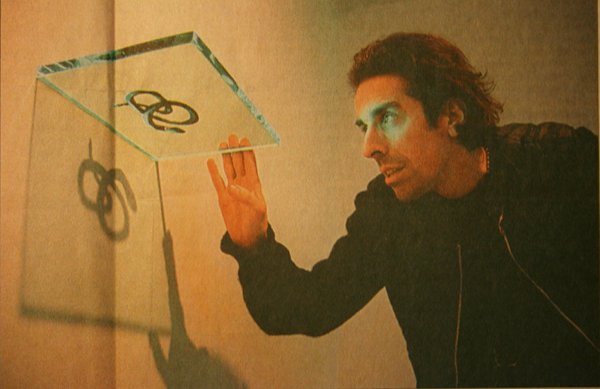
Daniel Dugas peers into a glass sculpture that is part of his recent art installation, FOUNDWEALTH
Art by Installation
Daniel Dugas’ last exhibit forced viewers to questions what it means to be wealthy
By Alison Hughes
in Sackville
LUMINOUS lighting emanates from seven surfaces in the dim room. It radiates through yellow plastic beads, shines on carved glass and illuminates messages set into plain white walls.
The exhibit’s overall effect is deceptively simple, but behind the constructions making up Daniel Dugas’ latest art installation is a complex thought process. Drawing on influences from medieval alchemy to modem economics, FOUNDWEALTH uses audiotapes, found art objects and sculpture to examine conflicting ideas about what it means to be wealthy.
A self-described “pluri disciplinary artist,” Dugas has been pushing the artistic envelope since completing a Bachelor of Fine Arts degree at the Université de Moncton, in 1986. His resume includes 12 solo exhibitions, 24 two-person and group shows, as well as dozens of audio, video, radio and performance credits.
Dugas bas received numerous Canada Council and provincial Creation grants for his projects, along with funding from several art institutes. These have led to travel opportunities throughout North America, Europe and Asia, including a role as a Canadian representative at the 1997 Jeux de La Francophonie, in Madagascar.
While working for a year at the Banff Centre for the Arts, Dugas met and began collaborating with his partner Valerie LeBlanc. Together, they headed off to the Art Institute of Chicago.
With LeBlanc originally from Halifax and Dugas raised primarily in Moncton, the two eventually moved to New Brunswick. Here, they gained notoriety in 1996 by travelling to small towns with an exhibit known as the Trunk Gallery. People paid a dollar to look inside the hatchback of a Citation to see the couple’s custom-designed audiovisual installation. After Peter Gzowski interviewed them about this unique way of taking art to the people, they received calls from all across the country.
“A lot of people would go to a Legion, but never to a gallery,” Dugas says. “There’s also a need for more populist art. I think it’s important for an artist to have reactions from many people in order to grow.”
In FOUNDWEALTH, Dugas questions whether wealth is anything more than a marketing illusion in today’s society. The show’s first installation is a wall-mounted piece of beveled glass with the exhibit title etched elegantly into the surface. In front of this hangs a bare bulb with a symbolic and functional string attached.
As a motor on the floor turns noisily around, it moves the string and causes a shadow title on the wall to shrink and grow with rhythmic regularity. This hypnotic motion draws in the viewer, suggesting wealth’s seductive power. Simultaneously, it reveals the crude machinery working behind the scenes to create expensive polished products.
Dugas cleverly combines public perceptions with personal research in offering his insights into the origins of wealth. Central to this installation, both physically and conceptually, is a circular light table. A pole rising from the centre represents the medieval greased pole where foodstuffs used to be hung during celebrations, for those hungry, agile and determined enough to reach them.
On the table itself, seven carefully chosen found objects are displayed like jewels. Each of the items, from a broken doll to a pinecone, has a word written on the surface, forming the sentence “I always thought there were seven seas.”
“The roots of wealth were originally the seven seas,” Dugas explains. “But when I got out a globe, I counted 33 seas. It’s like the growth of wealth parallels the number of seas. That’s the terrible beauty of the free market, that it always finds a way to grow,” he says. “It’s both creativity and cancer, and the role of society is to decide the boundaries.”
A voluminous and eclectic reader, Dugas explored economic limits in the exhibit through three seemingly unrelated men: 18th-century Scottish founder of capitalism Adam Smith, late-19th-century Pope Leo the 13th and mid-19th-century California lumber baron John Sutter.
A white plaster hand mounted in an opening in the gallery wall symbolizes the “invisible hand” Smith described as regulating the free-market economy.
Sutter serves as a warning that even hard work and capability aren’t enough to ensure wealth if the timing is wrong. The millionaire sawmill owner was ruined by the discovery of gold on his property and the subsequent gold rush fever. In the exhibit, a carefully crafted walnut light table holds a pile of yellow plastic beads that look like gold, but have no inherent value.
Having lived the hand-to-mouth existence of an artist for many years, Dugas has given considerable thought to the role of money in society. Like a magpie, he picked up shiny fragments about wealth from novels, financial pages and personal observations during the year it took to assemble the show.
While this installation hasn’t been purchased by a collecting institution, as others have been in the past, Dugas considers it a success. As he begins to dismantle these pieces, though, his mind is on the multitude of other projects awaiting attention. He has just published his fourth poetry chapbook and together with Ms. LeBlanc is preparing more manuscripts for a launch later this spring. Then, there is another word-based project involving parking lots and an audio production already under way. Dugas is also a musician.
“Projects are like kids. The one that squeaks the most gets finished,” he laughs. “Valerie is a very productive artist too. Often we say ‘gee, wouldn’t it be nice to just look out the window and be bored?’ ”
As well as pursuing their own art projects, the couple runs a high-end glass-carving business, producing presentation items and architectural details. Both enjoy the freedom of working together at home in Shemogue, not far from Shediac. Dugas still feels the urgency to communicate ideas through painting, sculpture and other media. Whether the projects are about nature and civilization, media manipulation, or found wealth, he plans to continue making art that stimulates thought about challenging subjects.
“With the crossing of the two millenniums, we’re a bit like in a corridor of weightlessness; the entry and the exit signs, the welcome and the goodbye signs, we don’t seem to have a specific place,” he muses. “I think it’s very important to have a feeling of hope and of the importance of what you’re doing- that it’s of value. ”
Telegraph Journal
April 17, 1999
Transitory (1993)
• The School of the Art Institute of Chicago, MFA Show, Chicago, IL, 1993
Outils sociaux (1993)
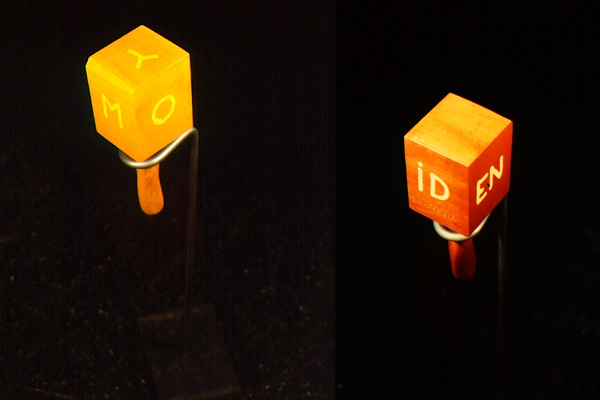
• Auction at Sculpture Space, Utica, NY 1993
L’installation comprends 11 maillets en bois teinté rouge ou jaune. Sur chaque maillet est gravé un mot idée: Temps, Space, Money, Loi, Duty, Riot, Assez, Rêve et Identité. Exploration de l’ambivalence et du contraste qui existe entre le concept de l’outil et le concept de l’arme, de la construction et la destruction.
Chaque maillet: 12 in h. X 5 in. w. X 5 in. d. tuge métallique: 30 in. h.
La boîte de Pandore (1991)
• Galerie d’art Louise et Reuben-Cohen de l’Université de Moncton, NB, 9 juillet – 31 août 2008
• A.K.A. Saskatoon, SK, June 7 – June 29 1991
• Galerie Sans Nom, Moncton, NB April 2 – April 23 1991
Created in January and February 1991 during a residency at Sculpture Space,Utica, NY, an internationally reknowned artist-in-residence program for sculptors.
The New Pandora’s box – an installation-projection about television.
I left Canada for England with a grant from the Canada Council – August 1, 1990 on the first leg of a world research trip. The idea was to revisit the myth of Pandora’s Box and to capture ‘evils of the world’ through video and sound recordings. The invasion of Kuwait by Iraq on August 2 forced me to change my itinerary and to reconsider the parameters of my research. During the 40 days of my travel, I saw a world glued to television sets, waiting for something to happen. Television as medium evolved to be both topic and base for my project.
The Installation was made of 5 elements, four buoys: rocking structures made of wood and the control cabinet: the disc. Each buoy was fitted with a slide projector and a cassette deck connected to the disc. Visitors could activate projections and soundtracks by opening the drawers of the cabinet.
The slides and the soundtracks were constructed with material garnered from television itself, photo stills and sound bites taken from talk shows and daytime TV.
The construction of The New Pandora’s Box took place at Sculpture Space from December 2, 1990 to January 30, 1991. Operation Desert Storm began with an aerial bombardment on 17 January.
Dimensions
4 pieces: 75 in h. X 24 in w. X 20 in d.
1 piece: 24 in dia. X 5 in h.
Soundtracks duration: 45 minutes
240 slides
Le poids de la beauté / The Weight of the Beauty (1990)
Work for 3 dead minks, one deer leg and 5 capitals
February 27 – March 1, 1990
Glyde Hall, The Banff Centre for the ArtsBanff, Alberta
Sur la route qui me ramène de Calgary
Au son de l’harmonica de Dylan
sur “What was it that you wanted”
Je croise un chien mort, so,
Je réalise que dans les Foothills,
on meurt aussi dans la Beauté
Cowboy Caruso (1990)
Saint Mary’s Unniversity Art Gallery Halifax, NS February 8 – March 11 1990
Cowboy-Caruso est une figure mythique qui veut le meilleur des deux mondes; la liberté et les grands espaces du cowboy et le raffinement du monde de l¹opéra. Basé sur l’histoire vraie de Ted Wilson ancien cowboy au Texas, travailleur dans les champs pétrolifères du Nord puis chanteur d¹opéra dans les rues de Calgary.
Deux structures reliées électriquement, l’une COWBOY, l’autre CARUSO engage via le spectateur un dialogue chaotique. Quatre tiroirs en forme de quart de lune peuvent être tirés hors de Cowboy. Chaque tiroir a une fonction spécifique: 1. déclenche le système sonore; le haut-parleur droit est installé dans Cowboy et le haut-parleur de gauche dans Caruso. 2. déclenche un baril tournant installé à l¹intérieur de Caruso. 3. déclenche un projecteur diapositives installé dans Cowboy. 4. déclenche un trophée tournant sur Cowboy. La structure Caruso est déposée sur une table de métal. Quatre chaises sont installées face à quatre ouvertures. Lorsque concordent les ouvertures dans le baril tournant avec les ouvertures sur la structure elle-même une scène mélancolique, éclairée avec des black light apparaît puis disparaît lentement. Il s¹agit d¹une forêt miniature faite de bois de chevreuils où pendent des médaillons photographiques. Sous la table sont éclairés avec des black light cinq fers à cheval fluorescents. La projection de diapositives vertes est constituée de gros plans de dessins de travaux quotidiens du cowboy. La bande sonore comprends des airs de l’ouest chantés par Ted Wilson. Le tout fut manipulé en studio.
Installation
2 pièces: 48 in. dia. X 12 in. h.
base de Cowboy: 48 in dia. X 48 in. h.
base de Caruso: 48 in. h. X 24 in. w. X 24 in. d.
Daniel H. Dugas
Archives
Blogroll
- A.I.R. Vallauris
- ACAD
- Adobe additional services
- Adobe Creative Cloud
- AIRIE
- Amaas
- Amazon Author Central
- ARTothèque
- Australian Poetry
- Basic Bruegel
- Bitly
- CCCA
- CDBaby
- Cycling 74
- Dissolution
- Éditions Prise de parole
- Emmedia
- eyelevelgallery
- FAVA
- Festival acadien de poésie
- Festival FRYE Festival
- FILE – Electronic Language International Festival
- Freeware list
- Fringe Online
- Galerie Sans Nom
- Gotta Minute Film Festival
- Instants Vidéo
- JUiCYHEADS
- Kindle Direct Publishing
- Klondike Institute of Art and Culture
- La Maison de la poésie de Montréal
- La Maison de la Poésie et de la Langue française Wallonie-Bruxelles
- Laboratorio Arte-Alameda
- Le Centre Jacques Cartier
- Liberated Words
- Maison Internationale de la Poésie – Arthur Haulot
- MediaPackBoard
- Miami Book Fair International
- Monoskop
- Mot Dit
- NSCAD University
- Paved Arts
- PoetryFilm
- Portail des auteurs du Nouveau-Brunswick
- RECF
- Revue Ancrages
- Salon du Livre du Grand Sudbury
- Sculpture Space
- Subtropics.org
- Sydney college for the arts
- The Centre for Contemporary Canadian Art
- The New Gallery
- Trevigliopoesia
- tumbler-documents
- V Tape
- Valerie LeBlanc
- VideoBardo
- Void Network-Κενο Δίκτυο
Categories
- #covidpoèmes
- Advertisement
- AIRIE
- Ancrages
- anthology
- Anthropocene
- Architecture
- Around Osprey
- art
- Article de presse
- arts visuels
- audio
- Australian Poetry
- Basic Bruegel Editions
- Book
- book fair
- Cafe Poet Program
- Ce qu'on emporte avec nous
- Citations gratuites
- Collaboration
- commentaire
- commentary
- Compte rendu
- conférence
- Conservation Foundation of the Gulf Coast
- COVID-19
- Critique littéraire
- culture
- Daniel Dugas
- Design
- Édition Michel-Henri
- Éditions Perce-Neige
- Éloizes
- Emmedia
- emoji etc | émoji etc
- Environnement
- essai
- essay
- Everglades
- Exhibition
- festival
- Festival acadien de poésie
- Festival Frye Festival
- FIPTR
- Flow: Big Waters
- Fundy
- Habitat
- installation
- Instants Vidéo
- interactivity
- journal
- JUiCYHEADS
- Kisii
- L'Esprit du temps
- laptop
- Leaving São Paulo
- lecture
- Livre
- logos
- Magazine
- Miami Book Fair
- Moncton 24
- novel
- OASIS
- oil spill
- perception
- performance
- Photo
- poésie
- Poetic Licence Week
- Poetry
- politics
- politique
- press
- Prise de parole
- Revue Ancrages
- salon du livre
- sculpture
- Sculpture Space
- sound
- Souvenirs
- Spirit of the Time
- Style & Artifacts
- Symposium d'art/nature
- talk
- television
- The New Gallery
- Uncategorized
- Valerie LeBlanc
- vidéo
- vidéopoésie
- Videopoetr/Vidéopoésie
- videopoetry
- visual arts
- What We Take With Us
- youth literature








